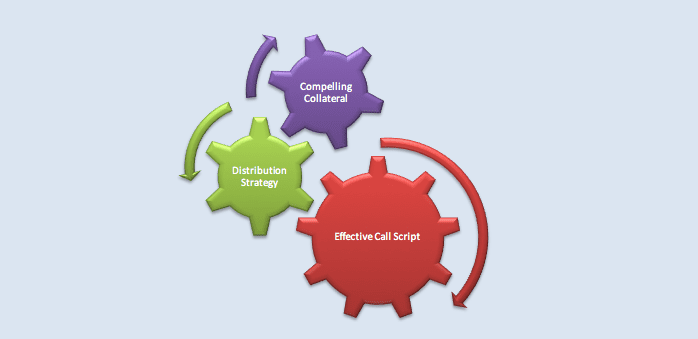In this article, you will find information to help you conduct a successful, repeatable appointment-setting process to increase sales opportunities.
Why Formalize a Marketing and Telemarketing Process?
Although it is possible to simply pick up the phone and start dialing for appointments, simply making calls in the blind without preparation and strategy will yield less than optimum results. Developing a consistent, repeatable marketing strategy that supports a solid telemarketing process to deliver effective call scripts will considerably increase the number of sales appointments set.
The 3 Tools Required for Maximum Appointment-Setting Success
There are three essential tools needed to maximize the results of an appointment-setting campaign, without which your marketing results will be less than effective and fail to yield a satisfactory ROI.
3 Tools

Compelling Marketing Messaging and Collateral
The first tool required to maximize success is compelling marketing messaging and collateral, which is posted to social media, mailed and emailed to your prospects in advance of your first telemarketing campaign. Visually pleasing, emotionally-charged messaging focused on a prospect’s pain points that reveals you as the answer to eliminating them is paramount to your appointment setters’ ability to shorten the time it takes to set appointments.
Effective Distribution Strategy
The next tool that is necessary to ensure the highest success of an appointment setting program is an effective marketing message and collateral distribution strategy. While it is important to have the right message and marketing collateral, it is just as important to distribute it to the right prospects at the right time. A key to the effectiveness of marketing messaging and collateral as preparation tools for appointment-setters and telemarketers is the timing and frequency of the distribution of these materials, and properly aligning call efforts strategically behind these marketing touches. This requires the development of a delivery schedule for each campaign and each activity in it, and the consistent execution of that schedule. Inconsistencies in the delivery schedule of postcards, brochures, emails, newsletters, social media posts and appointment-setting calls will negatively impact your results.
The number of times and consistency with which prospects see your company name, logo and messaging increases the likelihood of their accepting a call from your appointment-setter or telemarketer and agreeing to a sales appointment. The distribution program should be designed to deliberately inform prospects about specific services at specific points in time, rather than trying to inform them about all of your services at once.
Successful Call and Voicemail Scripts
The final tool needed to arm the appointment-setter or telemarketer is an effective call and voicemail script. The goal of creating these scripts is not simply to tell callers what to say – it is to ensure that they are all saying the same thing. The telemarketing script used by the appointment-setter should demonstrate the appointment-setter’s knowledge of not only the prospect’s vertical market, but the pain points they experience, and prepare the appointment-setter with the right questions to ask to evoke the emotion prospects need to feel in order to find the value required to engage in the provider’s services.
As appointment-setting can be a laborious task which follows specific steps in the sales cycle such as securing the appointment, preparing the prospect for the sale, properly setting their expectations, and executing the proper follow-up to maintain customer service, the proper execution of these important actions should not be left to memory. These actions and tasks should be clearly documented for the appointment-setter or telemarketer to follow in order to maximize their opportunities for success.
The process required for success
Once the outbound call team has been equipped with the tools required for success, a marketing strategy and its component processes must be developed. This process is comprised of six steps, and the specific order of each step in the process is vital to the success the telemarketing campaign.
The 6 step process

Acquire or Develop a Prospect List
The first step in the process is to acquire a prospect list. The prospect list should be filtered based on criteria such as your desired vertical market, number of desktops, gross yearly revenue and length of time in business of the prospect, and any other criteria that represents the persona of your ideal prospect.
Scrub the List
All marketing lists require a certain amount of scrubbing. Scrubbing is the process of verifying the accuracy of the list and the information it contains by calling it. The goal of scrubbing is not to execute the call script to attempt to secure an appointment – it is only to gather and verify information.
One way to scrub a list is to segment it into groups of 100 leads and call each prospect to verify the information on the list, such as if the contact person listed is the appropriate person to speak to about the your services, and if the mailing and email addresses are correct. During the scrub, it may be possible to discover if the prospect has the appropriate amount of PCs and servers to make the opportunity profitable for you, as well as if they have in-house IT staff or use an outsourced provider.
Scrubbing a marketing list is the best way to ensure that the investment in printing and mailing collateral and calling is not being wasted, and ensure that they are “Marketing Qualified Leads” (MQL), which improves your marketing ROI. During the scrub, it is recommended to let the gatekeeper or decision maker know that they will be receiving important information for review and that they will be contacted afterwards to confirm its receipt.
Market to the List
The next step of the campaign consists of mailing and emailing your marketing messages and collateral to the scrubbed list, and according to a consistent schedule. When incorporating email marketing into the campaign, you should stagger its delivery with other collateral to maximize the marketing impact of each individual marketing touch. The goal of the collateral is not to sell your services, but to generate interest and curiosity and prepare the prospect to receive a call from your appointment-setter or telemarketer.
The Follow-Up Call
The fourth step of the campaign consists of calling to set the appointment. At this stage, the appointment-setter should be well armed to initiate business, as they know exactly who to engage as the decision-maker and have had an opportunity to engage the Gatekeeper to develop a relationship and prepare them for this call. If you have scheduled the process properly, by the time of this call the prospect should have received your marketing collateral and messaging, which the appointment-setter can confirm before executing their call script to reinforce the importance of the information it contains.
Once the prospect confirms receipt of the marketing collateral, the appointment-setter can continue delivering their call script.

Set the Appointment
During the call, it is important that the telemarketer sets the appointment for the first sales call correctly. The goal and objective of the appointment is to close an IT Solution, Service or Managed Services opportunity, so it is important to properly prepare the prospect to be closed while setting the appointment for the sales professional to meet with them. To accomplish this, the appointment-setter should be candid and inform the prospect of your objective – to meet with them to discover if there is an opportunity for you to work together. Setting the appointment becomes easier as the prospect is informed that the visit is free and there is no obligation on their part during or afterwards.
Successful Appointment Follow-Up
If your telemarketer is successful and an appointment is set on the first follow-up call or any follow-up call thereafter, there are four important steps to follow that will increase your chances of closing the opportunity. The first step is for the telemarketer to send a “thank you” email to the prospect that also confirms the appointment through a calendar invitation. The second step is the mailing of a simple “thank you” card with a wet signature from you or your sales professional.
This step serves multiple benefits, including the execution of another marketing touch. The more marketing touches delivered to the prospect, the better the chances of closing business. The second benefit comes from a customer service perspective. In a world that is so email and text message-driven, the personal “thank you” card will have real impact and soften prospects up for the sales professional.
The third step is to call the prospect to confirm the appointment the day after the appointment is set. This is simply to execute a marketing touch and display excellent customer service. The final step is to call the prospect again 24 hours before the appointment for a final confirmation. As decision maker schedules change frequently, it is important to make sure the prospect will still be available to meet. This step again displays excellent customer service and follow-up and demonstrates the value placed upon the prospect’s time as well as your sales professional’s.
Unsuccessful Appointment Follow-Up
If the appointment-setter is unsuccessful in setting up an appointment, there are three actions they should take. The first step is to classify the lead – is the lead hot, warm or cold? Definitions for hot, warm, and cold may be subjective, but it is important that each telemarketer or appointment-setter work from the same definition to provide you a clear understanding of the status of all opportunities.
Typically speaking, hot leads are leads that verbally accept an appointment but need to verify a date and time or check with additional personnel. Warm leads are typically those that ask for a call back to further discuss the opportunity, and cold leads are everyone else. The second action is to determine who gets what collateral after the leads have been classified. It is important to continue to send marketing collateral to prospects and call them to set appointments; however, hot prospects should not be sent the same information as cold prospects. The telemarketing staff must have a clearly defined agenda of what prospect groups are to receive which follow-up messaging and collateral and according to what schedule. The third action is to stop at the appropriate time – it is important that the telemarketing team know when to stop putting effort into unresponsive leads. Time should not be wasted chasing cold leads forever. Conversely, hot and warm leads that don’t turn into appointments should be re-classified and handled appropriately.
Typically speaking, calling and emailing to leads more than 4 times each during a campaign is a reasonable limit, unless they are receptive to scheduling follow up calls and progressing closer to an appointment. Rather than continuing to call cold leads, it is a better idea to place them in your newsletter list and deliberately touch them in a passive manner every 90 days with customized quarterly messaging. Cold prospects will respond when they are ready.
Conclusion
An effective appointment-setting and telemarketing process will:
- Speed your marketing ROI
- Unify your marketing message and process
- Properly lead prospects through a consistent sales experience
- Arm telemarketers and appointment-setters with the information they need to succeed
- Establish a follow-up process for cold leads
- Shorten sales cycles







